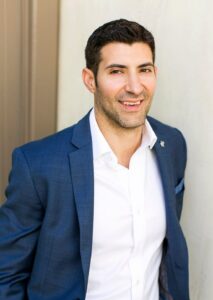An Interview With Fotis Georgiadis
Don’t compare — It’s easy to compare other successes with your own. Keep the focus on your own path.
As a part of our series called “Making Something From Nothing”, I had the pleasure of interviewing Ashley Wong.
Bookworm Baby was founded by Ashley Wong, a first-time mom and brand marketing vet who spent her time in New York at household beauty names such as L’Oréal, NARS and Butter London. She saw an opportunity to innovate in the teether category after noticing how often her little one gnawed on board books to soothe his achy gums. She created Basil the Bookworm teether — a first-of-its-kind, patent pending design with an adorable bookworm as the superstar to inspire a love of reading early on. With her extensive experience in marketing and newfound passion for little ones, Ashley set forth to bring safe, effective and best-in-class relief to all the little teethers out there.
Thank you so much for doing this with us! Before we dive in, our readers would love to learn a bit more about you. Can you tell us a bit about your “childhood backstory”?
I was born and raised in Texas. As an only child, I was fiercely independent starting at a young age. I was always driven, always determined and always had big dreams. I remember at the age of four, I took my dad’s tools, removed the training wheels off of my bike and taught myself how to ride. This pretty much set the tone for the rest of my childhood.
Can you please give us your favorite “Life Lesson Quote”? Can you share how that was relevant to you in your life?
Decide what you want. Believe you can have it. Believe you deserve it and believe it’s possible for you. — Jack Canfield
As a child or even in my professional career, I always believed you can make things happen even if it appeared to be out of my league. Be confident, decisive and find a way to get it done. If there isn’t one, create one.
Is there a particular book, podcast, or film that made a significant impact on you? Can you share a story or explain why it resonated with you so much?
I think it’s only fitting for me to choose a baby book. The Snail and a Whale by Julia Donaldson is a story about a tiny, yet ambitious snail who longs to see the world. The snail hitches a ride with a giant whale and during their adventure, the whale ends up in trouble. The snail comes to the rescue and proves anything is possible with fearlessness and perseverance.
At the start of Bookworm Baby, I had a great idea and needed to figure out how to make it come to life. The process was very intimidating. I had no connections or a “launch playbook” and although I had a brand marketing background, it was in a completely different industry — beauty. Launching a new patent pending product was completely outside of my comfort zone. But with a leap of faith and plenty of hard work, I was able to bring a first-of-its-kind teether to market.
Ok super. Let’s now shift to the main part of our discussion. There is no shortage of good ideas out there. Many people have good ideas all the time. But people seem to struggle in taking a good idea and translating it into an actual business. Can you share a few ideas from your experience about how to overcome this challenge?
Ideation should be rooted in authenticity, purpose and conviction. If you aren’t all-in on your own creation, why should the consumer believe in it? As part of the process, it’s critical to connect the creative with the business opportunity. Understand the market from all angles — the white space, both the target consumer & end users and the competitive landscape. Make sure the idea still has a strong likelihood to resonate with your market. Aside from all of this, my biggest piece of advice is there will never be a right time. Don’t wait, just start.
Often when people think of a new idea, they dismiss it saying someone else must have thought of it before. How would you recommend that someone go about researching whether or not their idea has already been created?
Do lots of research and never stop. Based on my experience, my approach was pretty straightforward, and my team studied a few key items: the product category (both domestically & internationally), the origins of our concept and the USPTO database.
For the benefit of our readers, can you outline the steps one has to go through, from when they think of the idea, until it finally lands in a customer’s hands? In particular, we’d love to hear about how to file a patent, how to source a good manufacturer, and how to find a retailer to distribute it.
Once our team solidified our concept, we set out to find the right manufacturing partner; a critical first step to our success given we were starting from scratch.
We identified a few best-of-breed manufacturers based on their client track record amongst other factors. The customer-centric partners who were willing to deploy their own engineering resources & vast expertise to help guide us through our first production process was key. Communication, follow-through & meeting deadlines were also top priorities.
As we progressed, we determined it was prudent to apply for a pre-launch, design patent to give us full protection. The patent process was a balancing act — understanding what type of patent paired with what should & can be submitted to provide the broadest coverage while maximizing the probability of an USPTO approval.
In terms of distribution, our launch strategy was D2C. We launched our website along with a social media rollout and soon thereafter, released our product on Amazon.
What are your “5 Things I Wish Someone Told Me When I First Started Leading My Company” and why?
- Stay the course — For every 100 no’s there might be one amazing yes. Be persistent and keep moving forward.
- Don’t compare — It’s easy to compare other successes with your own. Keep the focus on your own path.
- Never self-doubt — There are always doubters, but never doubt your vision.
- Progress is not linear — And that’s okay.
- Don’t rely on anyone — Seldom surprised, often disappointed.
Let’s imagine that a reader reading this interview has an idea for a product that they would like to invent. What are the first few steps that you would recommend that they take?
- Market Research — see what already exists, identify key players in the space (strengths, weaknesses), size the addressable market.
- Define the opportunity — what value-add or innovation can you bring.
- Create an action plan — lay out, sequence & prioritize the key workstreams.
There are many invention development consultants. Would you recommend that a person with a new idea hire such a consultant, or should they try to strike out on their own?
- It depends…for each piece of the puzzle, I asked myself can I already do it or figure it out? Going it alone allows you to set the vision, fully immerse yourself in the development process and most importantly, learn by iteration & failure. Be honest with yourself, know your limits and understand the timing implications.
- For non-negotiable items that are critical to success and outside of your core competencies — for Bookworm Baby, it was the character art & 3D modeling — leave it to the pros.
What are your thoughts about bootstrapping vs looking for venture capital? What is the best way to decide if you should do either one?
Bookworm Baby is fully bootstrapped as I want full control of the decision- making process. If you can fully fund the go-to-market with 6–12 months of ample runway (R&D, inventory and marketing spend), self-funding may be a preferable route.
Alternatively, external funding is an option if additional capital is required. Along with the funding, the right partner may be able to provide strategic advice and/or connect with distribution partners. However, ceding full control along with ongoing reporting requirements and resources required for fundraising were the downsides leading to self-funding this venture.
Ok. We are nearly done. Here are our final questions. How have you used your success to make the world a better place?
Going back to my mission — I want to create innovative relief that brings smiles and inspires the littlest ones to have an everlasting love for reading and discovery.
You are an inspiration to a great many people. If you could inspire a movement that would bring the most amount of good to the most amount of people, what would that be? You never know what your idea can trigger.
Be kind. Kindness brings the best out of people, and ultimately cultivates a more positive, inclusive community.
We are very blessed that some of the biggest names in Business, VC funding, Sports, and Entertainment read this column. Is there a person in the world, or in the US, with whom you would love to have a private breakfast or lunch, and why? He or she might just see this if we tag them.
Eric Carle. One of the most revered children’s illustrators and authors of all time. He has inspired many generations and his legacy continues to this day.
Thank you for these fantastic insights. We greatly appreciate the time you spent on this.
Making Something From Nothing: Ashley Wong Of Bookworm Baby On How To Go From Idea To Launch was originally published in Authority Magazine on Medium, where people are continuing the conversation by highlighting and responding to this story.



